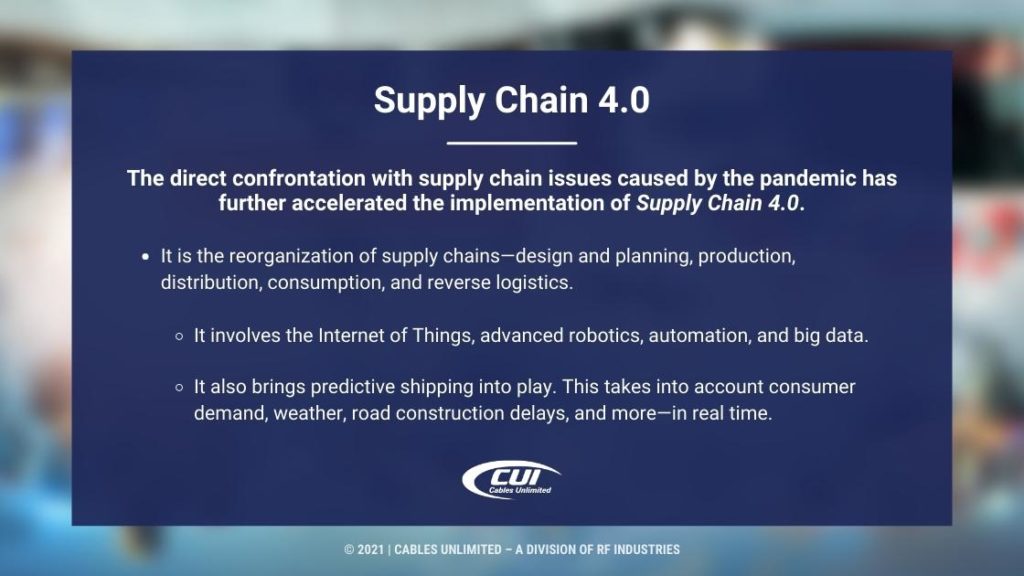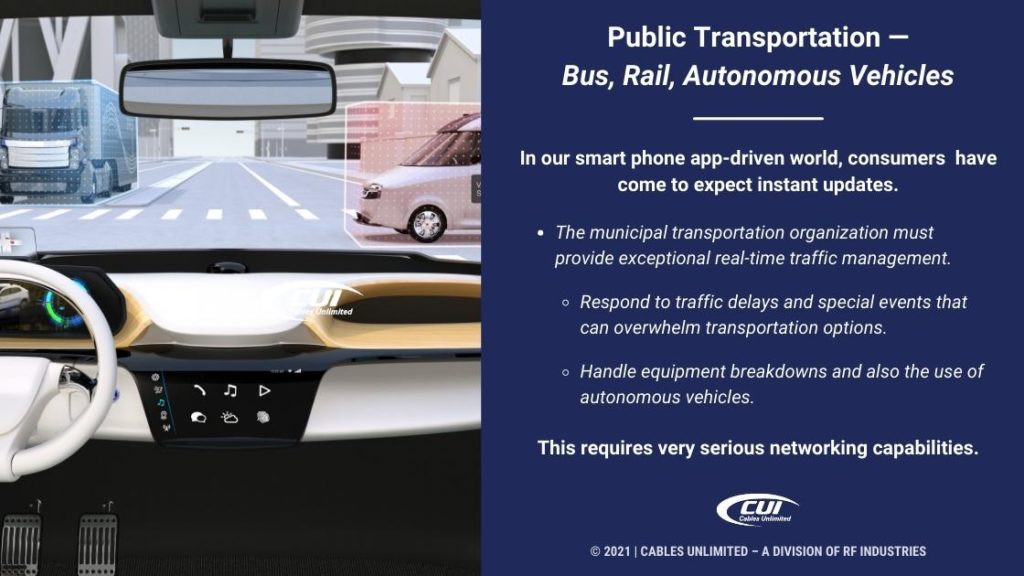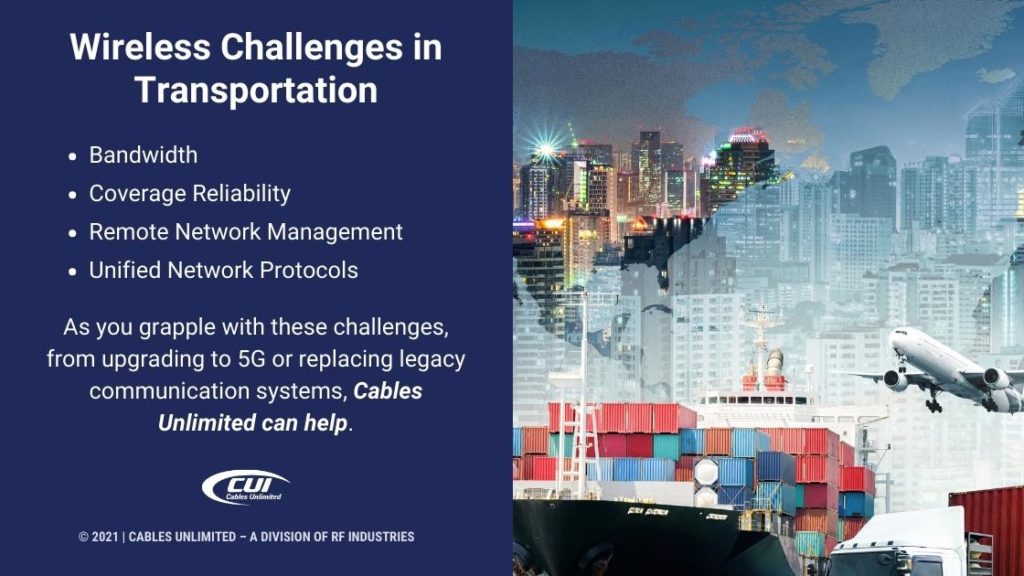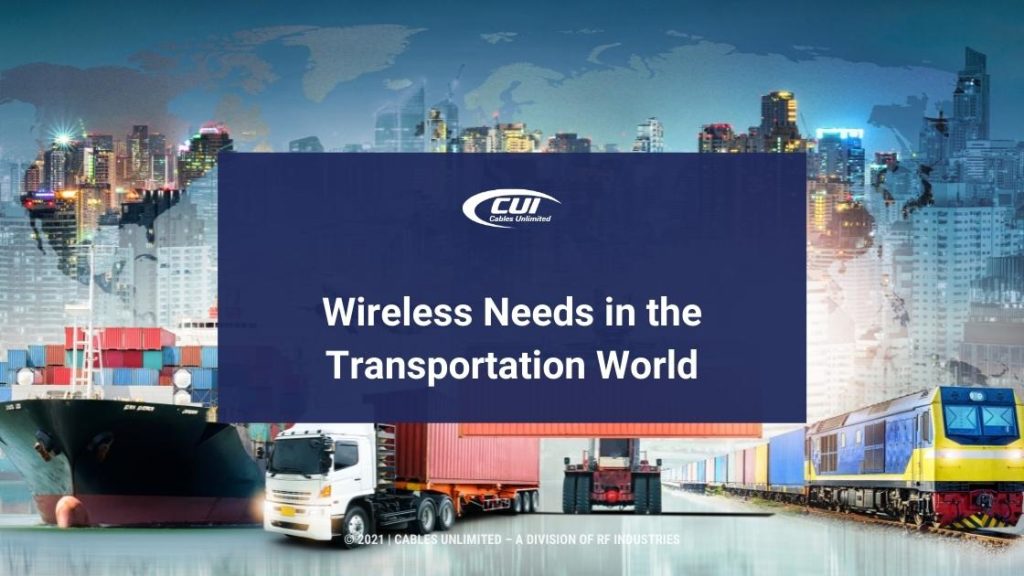As with so much of our world in the 21st Century, transportation is moving at the speed of light. Well, at least it is when the supporting data is traveling via electronic cables. That aside, mobile communication started the transformation. 5G networks promise to accelerate the ability to route and react in real-time to changing conditions, from delivery changes to cargo changes. And all of this happening in the blink of an eye. This article covers the wireless needs in the transportation industry from shipping ports to public transportation.
Transportation Industry — Shipping Ports, Trucking, Logistics Breakthroughs
We all experienced the breadth and pace of logistics improvements during the pandemic. Nearly everything was brought to our homes and generally on time. Amazon, UPS, FedEx, and even restaurant delivery services helped support our stay-at-home world with online ordering and rapid deliveries to nearly every single front door in America.
That same pandemic also greatly disrupted worldwide supply chains with challenges at shipping ports and delays in manufacturing due to raw materials and parts shortages. That direct confrontation with supply chain issues has further accelerated the implementation of Supply Chain 4.0.

Supply Chain 4.0 is the reorganization of supply chains – design and planning, production, distribution, consumption, and reverse logistics. All that involves the Internet of Things, advanced robotics, automation, and big data. From this effort comes predictive shipping that takes into account consumer demand, weather, road construction delays, and more in real-time — allowing the shipment of a product even before it’s ordered by the customer.
A key aspect of this change involving 5G networking is the ability to place a sensor on nearly everything. Vehicle-to-Vehicle (V2V) communication and Vehicle-to-Infrastructure (V2I) communication are two major applications. V2V can help with rerouting critical deliveries working between vehicles to make sure things arrive on time. V2I can allow communication between sensors on bridges, roadways, and even traffic lights and thereby facilitate routing changes on the fly to avoid costly delays.
Of course, all this goes into the cloud, bringing increased transparency of the full logistics system allowing vastly improved decisions in real-time to accommodate an ever-changing environment. It holds the promise of providing telemetry information from service vehicles and delivery trucks to track location, speed, idle time, and even fuel consumption. And that’s just the starting point.
Public Transportation — Bus, Rail, Autonomous Vehicles
In our smartphone app-driven world, we’ve come to expect instant updates. In public transportation, including bus and rail, this brings the requirement of updates on delays, finding better connections, warnings on crowding, along with ubiquitous high-speed wi-fi access.
All that’s from the perspective of the consumer, from the perspective of the municipal transportation organization they need to provide exceptional real-time traffic management. That includes responding to traffic delays and special events that threaten to overwhelm transportation options. There are also the inevitable equipment breakdowns.
This also brings about autonomous vehicles. They range from self-driving cars to automated delivery vehicles and even drones. All that requires some very serious networking capabilities.

Wireless Challenges in Transportation
There is a wide range of challenges in bringing seamless communication to the transportation industry as well as public transportation.
- Bandwidth. This is primarily a challenge with public transportation where bus and rail routers are attempting to deal with a wide range of devices and several different network carriers. Fortunately, this can be dealt with using the right equipment along with smaller data packets, particularly when compared to streaming video requirements.
- Coverage Reliability. You can imagine what happens when an autonomous vehicle loses wireless coverage. Fortunately, there are redundant systems to help when this occurs. But even so, coverage reliability is absolutely essential for nearly every one of the transportation industry applications.
- Remote Network Management. On the Internet-of-Things, where transportation is concerned, those things are nearly always on the move. This can make it extremely challenging to keep up with security and configuration updates, manage connection issues, and most anything else. This makes it very important to use the cloud to remotely manage these networks.
- Unified Network Protocols. Municipalities typically have a wide range of wireless networks from wi-fi to RF-mesh to LoRa and more. This requires integration gateways to bring all this information together to hand off communication between access points as vehicles move from one area to another.
Read more in our blog: What Are M12 Connectors and All Those Codes?

We Can Help with Your Transportation Wireless Needs
As you grapple with these challenges, from upgrading to 5G or replacing legacy communication systems, we can help. Our M12 cable assemblies range from half a meter to 500 meters with exactly the right M12 connectors for your application. We also offer custom wire harness assemblies as well as a wide range of Ethernet cabling solutions from Cat7, Cat6, Cat6A, and Cat5e cables, meeting every networking criteria.
If you are in the design stages of your transportation-related cabling solution, we can provide engineering assistance and prototyping. If your requirements are already specified and ready for a quote, we are uniquely positioned to meet your deadlines and pricing targets, due to our extensive in-house services and advanced manufacturing capabilities.
With production facilities on both coasts of the United States, Cables Unlimited can assist customers here and worldwide with their most challenging custom wire harness and assembly requirements.
But we offer much more than state-of-the-art manufacturing – our dedicated team is also known for going to great lengths to meet the needs of our customers, including working round-the-clock to meet tight turnaround requirements.
Our sales representatives are standing by to assist you with product questions and quotes Monday – Friday, 8:00 am to 5:00 pm Eastern. You can also send us an email or complete our contact form and we’ll get right back to you.




